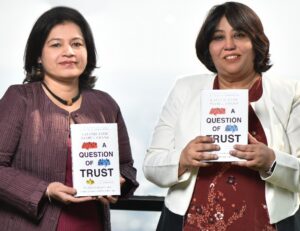
Literary Speaking: Trust makes a brand in the age of social media
 By Ranjit Monga*
By Ranjit Monga*
All communication is based on trust. If you trust a brand, a person, a product or a company, then you will engage with it and this has become very, very strong post-pandemic, says Paarul Chand co-author of the Book, A Question of Trust.

The book is a handbook for CEOs for effective communication and building trust. In this age of heightened communication, where we can get in touch with someone within seconds through our smartphones and through social media tools, the book is a lesson in navigating through the web of internet-based communication platforms.
“There is a very big trust deficit in the world right now and social media has only added to it. Anyone can destroy the reputation of a company or a brand within seconds by sending out a negative post on a social media account, tagging the CEO of a company,” says Chand.
“And the fact that you have AI (Artificial Intelligence) models like ChatGPT now entering the situation, it’s become even more tricky,” she adds. The author recalls a recent photography contest where the winner revealed that his photograph was finalised using AI. “So, with these kinds of things happening, it’s very difficult to know who to trust and who not to trust,” she says and admits that there are no easy ways to handle such situations.
CEOs have to be constantly available on Social Media
“The only thing people have realized is that they have to be constantly available on the channels where the customers or their audiences are and that they themselves have to be larger than their company or product. It’s no longer enough to say I produce a certain biscuit or a soft drink, they also have to show their social conscience on their sleeves,” she explains.
Chand has had a long inning in communications. She was a television journalist for eight years, before striking out in the field of public relations and media consultancy. She has also been a documentary filmmaker and is presently editor of PR Moment India, which is a UK-based magazine on the public relations industry.
Chand believes that there is a tremendous change in customer expectations and service, especially in the post-pandemic era. “Previously most of us were used to bad customer service, but that no longer holds true. If a customer doesn’t like something the first thing, he or she does is express it on social media. In the book we have described the new customer as being akin to the persona of the angry young man personified by Amitabh Bachchan in Bollywood films of the 70s and 80s,” she says.
A social media post can have a domino effect. A large number of posts can go out within seconds and go viral. “But the good thing is also that the duration of a news cycle on social media is very short. It does not sustain for more than a couple of hours unless it’s something very long-term,” she offers.

Chand and her co-author Gayatri Rath, have several messages for CEOs in their book. “I would say the most important messages are about how to clean up your own communication and a lot of the book is about the importance of the corporate communication and PR department in companies which can sometimes be the most ignored departments since they are a cost centre and not a profit centre,” says Chand.
The communication plan should be tailored to individuals
For the CEOs themselves, the authors have included detailed plans about how to organise communication according to their personal style. “If I’m not a person who’s comfortable in front of a camera and I’m more comfortable writing, then I should do that. Just because everybody is doing a podcast or a video blog, it doesn’t mean I have to also do those. If I’m not good at social media, then I should not be trying to attempt social media unless it’s happening in a very controlled way by my corporate communication department. So, the message is that tailor your communication to what you’re comfortable with. That’s very important, “she explains.
An important question dealt with in the book is can you avoid being on social media?
“I would say no, you cannot avoid being on social media as a CEO. But you can pick and choose where you want to be. Maybe I want to be only on LinkedIn. There are people like Anand Mahindra, who’s a case study in ‘Twitter’ writing. His presence on Twitter is very regular, and he sends out really good quality tweets,” says Chand.
The book also discusses how CEOs are increasingly coming under pressure to comment on social issues in India. Chand suggests that CEOs could comment on things which make them comfortable, and which is in keeping with their company ethos. “Today, there are many issues like class, there’s religion, there is gender, inequity, and now increasingly, LGBTQI inclusion is a very important issue. But you are not required to comment on each and every issue,” she advises.
“Should they push themselves to comment more? Yes. Should they comment on each and every issue? Here, I think you have to have a deciding space on what you’ll comment on and that has to somewhere tie in with your brand,” she cautions.
The book discusses the role of corporate communication teams in detail. “A good communicator should be able to offer strategic advice to the CEO. What are the communication buckets you want to focus on? What is the one cause that you want to focus on for the long term which is in keeping with the philosophy of my company? What is my crisis communication plan if I’m targeted by what they call activist shareholders? What about fake news? Fake news is one of the biggest challenges. So, they have to be much more strategic, “ she points out.
Influencers should follow the guidelines of ASCI
Speaking about individuals who have become influencers, Chand says that the communication parameters for them are similar to those which are applicable to CEOs.
She says that one of the most important things to be kept in mind by influencers is to follow the rules and regulations set by the ‘Advertising Standards Council of India’ (ASCI). “It is no longer like the early days of being an influencer, where you could say anything and get away with it. Now you have to be transparent and if you are promoting a brand or a product or a service you have to clearly say that,” she explains adding that the ASCI is a statutory body, which can enforce the rules legally.
Elaborating on how to get your social media act together, Chand suggests identifying what you are passionate about and making that your identity on social media. “If you try to force yourself into a trend that would never work. Also, check which medium suits you most. Are you a reels person, a podcast person or do you like writing long posts on LinkedIn, then work accordingly, “she says and adds that it is not as if a serious subject cannot be taken up on Instagram and that only a serious subject can be taken up on LinkedIn. “You have to write with a lot of value and you have to be totally authentic, then it will work,” she points out.
Being regular in your posts is of utmost importance too. “If possible, start with a bank of at least two months of content because invariably you’re going to miss a week or two, so you will have something to fall back on,” she opines.
Offering tips for being a good spokesperson, Chand suggests getting to know your material well and practising by reading it out aloud to oneself. “Write out a script if you are unsure about what you want to speak about, I would say write out a script and then throw it away and learn to speak without the script because there is no substitute for sounding real and natural. And speak in a language you are most comfortable in,” she adds.
Her tip for a CEO pertains to mental health. “There’s never been as much pressure to communicate as there is today. That takes a mental toll. So, I would say that the biggest tip for the CEOs is to get a coach, to get a mentor, a safety partner and talk things through in a safe space with a person you trust,” Chand recommends.
*Ranjit Monga is a senior journalist and documentary filmmaker





